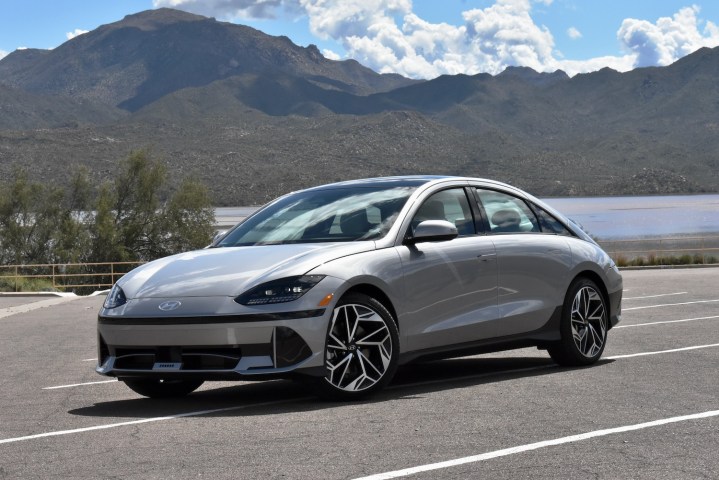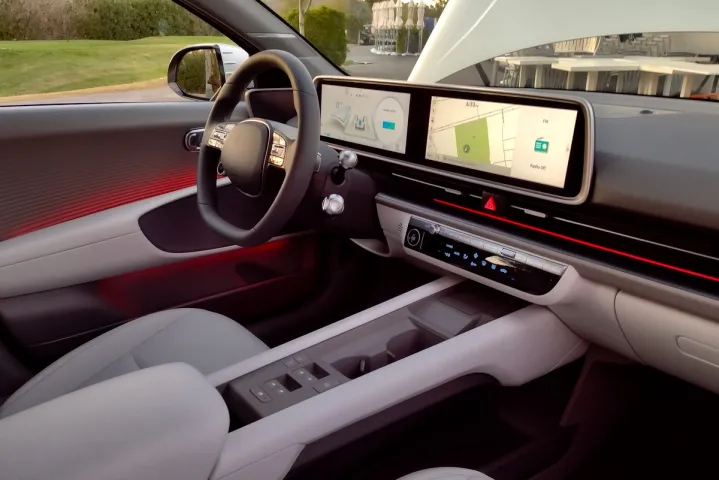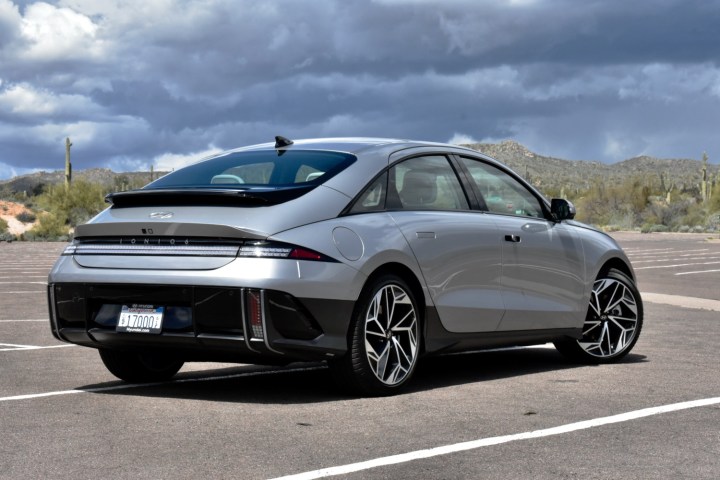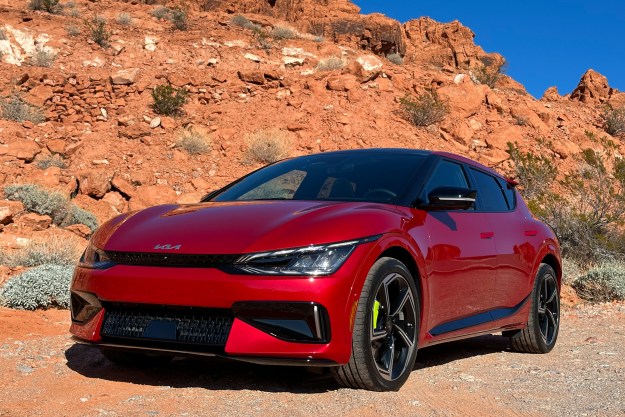While some automakers are just beginning to get into electric cars, Hyundai’s EVs have already taken several evolutionary steps. From the Ioniq Electric to the Kona Electric to the Ioniq 5, the South Korean brand’s EVs have steadily become more sophisticated in tech and design. And Hyundai isn’t stopping.
The 2023 Hyundai Ioniq 6 is a follow-up to the Ioniq 5, wrapping the earlier model’s hardware in very different styling. With the Ioniq 5 and most other EVs from mainstream brands are marketed as crossover SUVs, this sedan doesn’t have much direct competition. Hyundai set out to compete with the Tesla Model 3 and Polestar 2, which is reflected in its comparable pricing — between $42,715 for the base version and $57,425 for the most expensive model. But constantly fluctuating Tesla prices and build configurations mean that may not be the case for long.
That price range covers SE, SEL and Limited trim levels with two battery pack sizes and two powertrains: single-motor rear-wheel drive or dual-motor all-wheel drive. We spent a day in Scottsdale, Arizona, driving the top Limited model with all-wheel drive and the larger of the two battery packs.
Design and interior
The Ioniq 6 is based on the Hyundai Prophecy concept first shown in 2020. While some styling elements, such as the pixelated headlights and taillights, carry over from the Ioniq 5 to create a sense of brand identity, the Ioniq 6 trades its sibling’s eight-bit edges for smooth surfaces shaped by the wind tunnel.
Limiting aerodynamic drag helps increase range, and Hyundai went for broke here. It claims a drag coefficient of 0.22 for the Ioniq 6 — a significant improvement over the Ioniq 5’s 0.28 and the best ever for a Hyundai production vehicle. That focus on aerodynamics also gives the Ioniq 6 a distinctive look that admittedly isn’t for everyone. The window and rooflines arch up in the middle, making this Hyundai look a bit like an elongated Volkswagen Beetle. The flat rear spoiler, which looks like it belongs on a 1980s Porsche 911 Turbo, lends a similar Germanic touch. It also doubles as the third brake light.
The Ioniq 6 is still based on the Electric-Global Modular Platform (E-GMP) used by the Ioniq 5, as well as the Kia EV6 and Genesis GV60 from Hyundai’s other brands. But the sensation from behind the wheel is unlike any of these other models. Every other E-GMP vehicle to date has been marketed as an SUV, so you sit relatively high. In the Ioniq 6, you sit low and fairly close to the front wheels, which provides a feeling of skimming along the surface of the road rather than driving on it.
The interior is also just plain cooler than the minimalist cabins of Tesla and Polestar.
Hyundai also chopped the wheelbase by 2.0 inches compared to the Ioniq 5, which is normally detrimental to interior space, but the Ioniq 6 still has more front legroom and about the same amount of rear-seat legroom as the Ioniq 5. However, the Ioniq 6’s 11.2 cubic feet of trunk space is small even compared to Hyundai’s gasoline sedans. It’s the same story when comparing the Ioniq 6 to the Tesla Model 3 and Polestar 2: headroom and legroom are fairly close, but the Tesla and Polestar offer more cargo space. Both also have proper frunks (the Ioniq 6 only has a tiny storage tray under its hood), while the Polestar is a hatchback, with a bigger opening for loading and unloading cargo.
The interior is also just plain cooler than the minimalist cabins of the Tesla and Polestar. Instead of simply stripping things out, Hyundai added interesting design elements like a dashboard with upturned ends — which nicely frame the display screens — and contrasting textured elements for the door panels. The interior also features sustainable materials, such as carpets made from recycled fishing nets. And while many cars feature ambient lighting, the Ioniq 6 is one of the few that feels like it was actually designed for it. At night, light emanates from the various folds in the door panels and dashboard in a unique way.
Some aspects of the interior take some getting used to, however. The door lock and window switches are on the center console, rather than on the doors, as in most other cars. The shifter protrudes from the steering column at a low angle, so you have to look down to see it. However, these choices contribute to the interior’s clean look, and we got used to them pretty quickly.
Tech, infotainment, and driver assist
The Ioniq 6 gets a standard 12.3-inch touchscreen and 12.3-inch digital instrument cluster, which are placed side by side in one housing to form a single expanse of screen running about halfway across the dashboard. Apple Car Play and Android Auto are standard, but in wired form only. A head-up display isn’t available at all, because it couldn’t be packaged on the narrow dashboard, but the large instrument cluster meant we didn’t really miss this feature.
An updated version of Hyundai’s Digital Key system, which lets drivers use a smartphone or smartwatch in place of the key fob, now works with iOS devices, including Apple Watches, as well as certain Samsung phones. Hyundai also plans to add Google Pixel compatibility at a later date. Digital Key is part of Hyundai’s Bluelink telematics package, which is now free for the life of the 4G LTE network. Other Bluelink-enabled features include roadside assistance, battery preconditioning, and over-the-air updates, which Hyundai claims will allow it to push new features and fix problems without dealership visits, à la Tesla.
The driver-assist system was a bit sluggish when changing lanes and adjusting speed.
The complement of driver aids hasn’t changed much from other Hyundai models. Forward collision warning, lane keep assist, blind-spot monitoring, and adaptive cruise control are standard. SEL and higher models add blind-spot collision avoidance assist (which actively intervenes rather than just warning the driver) and Highway Driving Assist 2, which dials up the functionality of adaptive cruise control. Limited models also get Remote Smart Parking Assist 2 automated parking and Blind-Spot View Monitor, which shows a camera view of the blind spots in the instrument cluster when turn signals are activated.
As before, Highway Driving Assist 2 can automatically accelerate and decelerate the car while keeping it centered in its lane, but a new camera and radar array has enabled some new features here. The system can now make automated lane changes, respond to vehicles cutting in ahead, and shift the car over if another vehicle intrudes on its lane, but drivers still have to keep their hands on the wheel at all times. In the Ioniq 6, we found the system to be a bit sluggish when changing lanes and adjusting speed. Like many other similar systems, it also had trouble with curves, tending to ride the extreme outside edge of the lane.
Driving experience
The SE RWD Standard Range model gets a single electric motor producing 149 horsepower and 258 pound-feet of torque, rear-wheel drive, and a 53.0-kilowatt-hour battery pack. You can also opt for a 77.4-kWh pack with the single-motor rear-wheel drive powertrain, which also brings an upgrade to 225 hp while keeping torque unchanged.
The Ioniq 6 is a major improvement over the Ioniq 5 in terms of driving dynamics.
Hyundai also offers a dual-motor all-wheel drive powertrain. The larger battery pack is mandatory with this setup, which extracts a combined 320 hp and 446 lb.-ft. of torque from the two motors, one of which powers each axle.
The Ioniq 6 is a major improvement over the Ioniq 5 in terms of driving dynamics. Where the Ioniq 5 was both clumsy and uncomfortable, the Ioniq 6 strikes an excellent balance between handling and ride quality. The suspension has plenty of compliance, preventing jolts from road imperfections from penetrating the cabin, but The Ioniq 6 isn’t afraid of corners. While definitely not a sports sedan like the Tesla Model 3 and Polestar 2, the Ioniq 6 glides through corners with confidence.
EV fans and first-timers alike will also appreciate Hyundai’s adjustable regenerative braking system. Using steering wheel paddles, you can adjust the level of regeneration through four settings, allowing the Ioniq 6 to coast like a gasoline car or engage one-pedal driving, the latter of which can bring the car to a complete stop in stop-and-go traffic. Hyundai also included a “smart” option that uses the car’s forward-looking radar to scan for other cars and increase the level of regeneration when a car in front decelerates — almost like adaptive cruise control.
Range, charging, and safety
The Ioniq 6 impresses with a maximum range rating of 361 miles for the SE RWD Long Range model. That’s a big improvement over the Ioniq 5’s 303-mile best effort with the same-size battery pack, and beats the 358-mile Tesla Model 3 Long Range. Most other configurations still top 300 miles as well, and even the base SE RWD Standard Range gets a respectable 240 miles out of its smaller battery pack. We also saw an impressive 3.9 miles per kWh in our Limited AWD Long Range test car, indicating the Ioniq 6 will get the most out of a charge in the real world.
Hyundai’s E-GMP platform also includes 800-volt charging hardware, allowing the Ioniq 6 to DC fast charge at 350 kilowatts and complete a 10% to 80% charge in 18 minutes, according to Hyundai. The Ioniq 6 can also Level 2 AC charge at up to 10.9 kW, which Hyundai says can fully charge the battery pack seven hours and 10 minutes. Vehicle-to-load (V2L) capability also allows the Ioniq 6 to output power at 1.9 kW to run devices or (slowly) charge other vehicles, either through the charge port or an optional outlet under the rear seats.
Like its Ioniq 5 sibling, coverage for the Ioniq 6 includes a five-year, 60,000-mile new vehicle warranty and 10-year, 100,000-mile powertrain warranty, as well as a 10-year, 100,000-mile battery warranty. Crash-test ratings for this freshly minted EV aren’t available yet.
How DT would configure this car
Getting the most tech means upgrading to the top Limited trim level. The midlevel SEL includes most of the available tech features, such as Digital Key and Highway Driving Assist 2, as well as wireless phone charging, but the Limited model adds Remote Smart Parking Assist 2, the Blind-Spot View Monitor, and an upgraded eight-speaker Bose audio system.
The SEL and Limited have the same ranges — 305 miles with rear-wheel drive and 270 miles with all-wheel drive — while the Limited costs an extra $4,900. Our all-wheel drive Limited test car rang up at $57,425, which tops the base prices of the dual-motor all-wheel drive Polestar 2 and the Tesla Model 3 Performance. The Tesla also offers more range, while the Polestar is at a deficit of just 10 miles.
Alternatively, the lower-level SE RWD Long Range version offers 361 miles of range — more than Tesla or Polestar can muster — and starts at $46,615. That’s less than the cheapest Polestar 2, and at the time of publication, the only Model 3 you get for less is the base rear-wheel drive version with 272 miles of range.
Hyundai is known for value, but that isn’t the case here. The Ioniq 6 offer impressive range and well-executed tech, but you can’t have both. It’s also not as engaging to drive as a Model 3 or Polestar 2, or as practical. For everyday use, though, the Ioniq 6 offers a pleasant driving experience, as well as more daring styling than its rivals. If you want to feel like you’re driving into the future, this is the car for you.
Editors' Recommendations
- Lanzador concept previews Lamborghini’s first EV
- Tesla shows off first Cybertruck after two years of delays
- Mercedes-AMG EQE SUV first drive review: a better electric SUV
- 2024 BMW i5 unveiled as the first electric 5 Series
- Mercedes-Benz EQE SUV first drive review: ’90s look, cutting-edge tech








